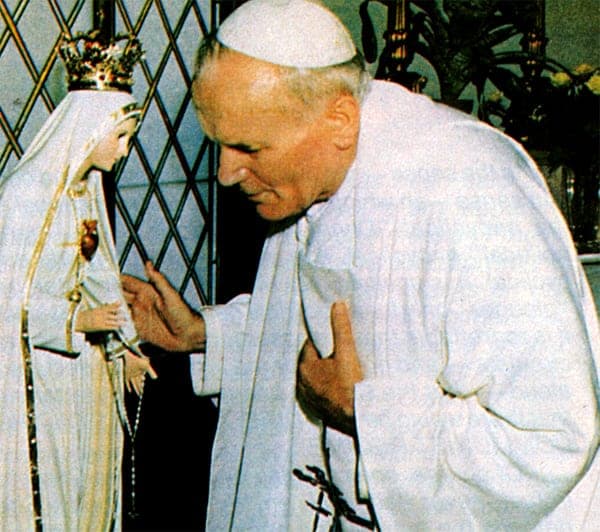FATIMA, Portugal — Aside from being day two of Pope Francis’s visit to this fabled Marian shrine, May 13, 2017, also marks the 36th anniversary of an assassination attempt against St. John Paul II, who was shot in St. Peter’s Square in 1981.
John Paul firmly believed Our Lady of Fatima saved his life, a reminder of how the Fatima devotion and the physical safety of the pope have long been intertwined.
For several reasons, the 1981 assassination attempt was a history-making event. It led the Vatican to exponentially expand the protection of the pontiff, including the bullet-proof glass that protected the pope ever since, until the election of Pope Francis.
A New York Times report from the time quotes a nurse saying that John Paul II had asked: ”How could they do it?”
The gunman, Mehmet Ali Agca, fired four times in the attack. Though history has forgotten them, two tourists were also wounded, including Ann Odre of Buffalo, who was 58 at the time. She had to undergo surgery so that a bullet could be removed.
Rose Hill, a 21-year-old from Jamaica, was slightly wounded in one of her arms.
John Paul II was convinced that Mary, in the form of Our Lady of Fatima, had personally redirected the bullet that hit him, saving his life. He gave a bullet recovered from the Pope-mobile to the local bishop in Fatima, who placed it in the crown of the official image of Mary in the shrine of Fatima, which Pope Francis will venerate.
A year after the first assassination attempt, John Paul II visited Fatima to give thanks to the Virgin for preserving his life.
The 1981 assault, however, was not the only assassination attempt against a pope linked to Fatima.
The day before the anniversary of that attack, on May 12th, 1982, a Spaniard broke through a security line at Mass with a bayonet and successfully stabbed the pontiff before being subdued by security.
Father Juan María Fernández Krohn, who had been ordained a priest in 1978 by the traditionalist Society of St. Pius X, the order founded by Archbishop Marcel Lefebvre as a response against the Second Vatican Council.
Krohn became radicalized, and was expelled from the ultra-conservative group. He attack the Polish pope because he was convinced that Communism had infiltrated the Catholic Church, and that John Paul was himself a Communist agent bent on destroying the Church.
Krohn broke through a security line at the Mass the pope was celebrating in Fatima, and – using a bayonet – managed to scratch the pope, though no real damage was done: He continued on with the celebration as if nothing had happened, with his wound bandaged and concealed.
The fact that Krohn had actually wounded the pope wasn’t revealed until 2008, when John Paul II’s long-time secretary, Cardinal Stanislaw Dziwisz, told the story in a documentary.
Krohn was sentenced to six years in prison by the Portuguese authorities, but served only half, and was eventually expelled from the country.
“I can now reveal that the Holy Father was wounded,” Dziwisz said in 2008. “When we got back to the room (in the Fatima sanctuary complex) there was blood,” Dziwisz said in the documentary, called “Testimony.”
These two failed attempts against John Paul II weren’t the only ones in modern history. The first one took place back in 1970, when Pope Paul VI was attacked with a knife at the airport in Manila, Philippines, shortly after his arrival in the country.
The police identified the would-be assassin as Benjamin Mendoza y Amor, 35-year old at the time, from La Paz, Bolivia. He was a mentally-ill artist living in the Asian country at the time.
“Death to superstition!” he yelled, according to reports of the incident.
Mendoza managed to wound Paul VI, having disguised himself as a priest. He was subdued by the pope’s personal secretary, Pasquale Macchi.
As happened with John Paul II’s second attack, both Pope Paul VI and the Vatican downplayed the incident, not even acknowledging he had been hurt until after his death, when the pope’s secretary, Archbishop Pasquale Macchi, spoke about it.
“If you ask me what the Pope’s most beautiful smile was, it came during the attempt on his life in Manila,” Macchi told the Philippine’s UPI. “After I pushed back the attacker, who wounded Paul in the chest, fortunately not lethally, I turned to face the Pope.
“I will never forget his sweet smile,” he continued. “And when he met my eyes it was as if he was somehow chastising me for the violence with which I pulled the assailant away to the police. It was as if he was enjoying a moment of inspired joy.”
















